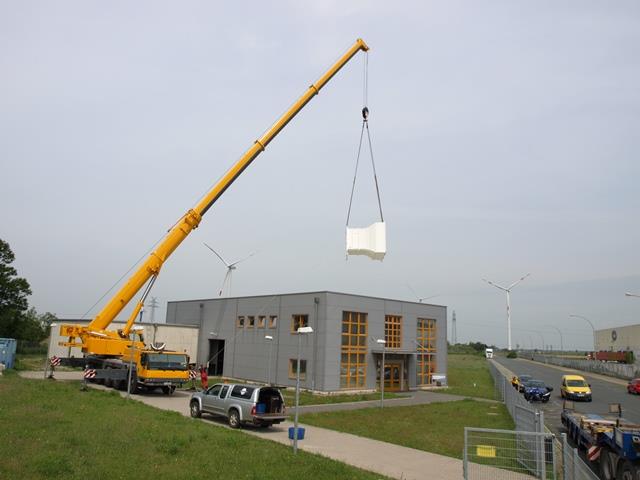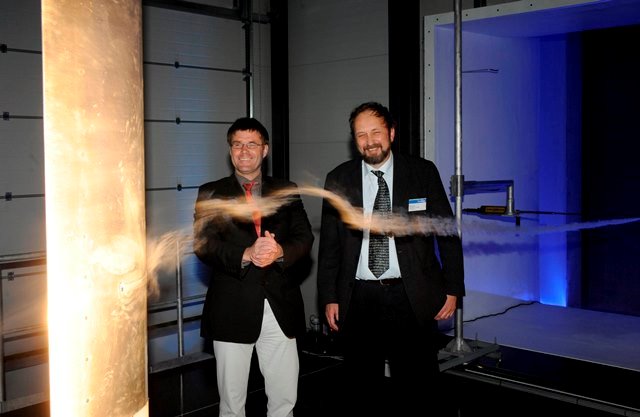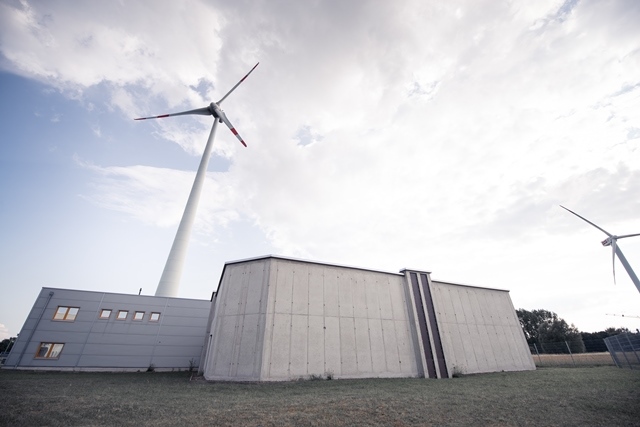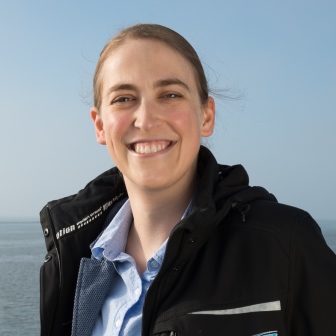A wind tunnel designed for the needs of the wind industry
Ten years ago, the first wind tunnel specifically designed for the needs of the wind industry was inaugurated in Bremerhaven. Get insight into ten years of wind tunnel history from our head of aeroacoustic wind tunnel testing, Nicholas Balaresque.
Like many things in the early years of wind energy, the first rotor blade designs for wind turbines were adapted from the aviation industry. It soon became clear that this approach had its limits: wind turbines have completely different requirements not only in terms of aerodynamics, but especially with regards to aero-acoustics. Turbine manufacturers set up R&D departments to improve the performance of their blades. To test their designs and models, they relied on wind tunnels. Again, they made use of the existing wind tunnels, which were often 30 to 40 years old and designed to test airplanes or buildings.
However, with the wind industry constantly growing, issues like noise emission became more and more important in the development of new blade designs.It soon became apparent that the existing tunnels with their high background noises could not provide the testing conditions for the new industry requirements.
Planning for the wind tunnel began in 2006
In 2006, WindGuard’s Knud Rehfeldt and his team set out to develop a wind tunnel specifically for the wind industry. It would have to have an excellent flow quality, a low background noise, achieve wind speeds of 250 km/h and more and Reynolds numbers of at least 4.5 million. The tunnel was built in 2007 and inaugurated in 2008.
- Installation of the Wind Tunnel Nozzle
- WindGuard CEOs Dr. Knud Rehfeldt and Gerhard Gerdes at the Inauguration of the Wind Tunnel in 2008
- The Wind Tnnel in Bremerhaven
To reduce the sound of the wind tunnel itself, the tunnel is built with acoustically-decoupled sections, and incorporates approximately 2000 m² of special noise absorbing elements. In 2011, in order to keep up with customer’s wishes, the maximum wind speed was increased to 360km/h (100 m/s), reaching Reynolds numbers of up to 6 million, with 0.9m chord airfoils.
Today, after 10 years of operation, well over100 different airfoils tested and several thousand measurements, the wind tunnel is running and regularly adding new capabilities. The newest service being high-speed, high framerate full airfoil deformation measurements, that allow characterizing the fluid-structure interaction of flexible airfoils.
To hear a bit more about the history of the wind tunnel, WindGuard Insight sat down with Nicholas Balaresque, Head of Aeroacoustic Wind Tunnel Testingin Bremerhaven and asked him about the last 10 years.
Interview with Nicholas Balaresque, Head of Aeroacoustic Wind Tunnel Testing
WindGuard Insight: Dear Nicholas, first of all congratulations to the 10th anniversary of the large scale wind tunnel center of Deutsche WindGuard! Can you imagine that already 10 years passed by since you started here in Bremerhaven?
Nicholas Balaresque: It’s hard to believe it has already been 10 years since the wind tunnel’s start of operation! It’s already 8 years since the first commercial airfoil tests.
WindGuard Insight: What gave your team the idea of building this wind tunnel?
Nicholas Balaresque: Some customers that regularly used our calibration wind tunnel approached WindGuard and asked if we could build a wind tunnel for rotorblade aerodynamics. After we made sure there was real interest in the industry, the project got started very fast.

The acoustically optimized large scale wind tunnel with its specific design is particularly apt for aero-acoustic research & development projects. It also allows for testing on comparatively large components and realistic models. Calibration and function tests of wind measurement sensors at high flow velocities are also possible, just as the use for R&D projects for the industry as well as for scientific institutions.
Features of the Acoustically Optimized Large Wind Tunnel in Bremerhaven
- 360-degree polars possible with simultaneous pressure and force measurement (Measurements from different angles of attack)
- Acoustic test section with 80 microphones
- Redundant measurement system
- Thermography for boundary layer flow visualization (in cooperation with BIMAQ)
- Online control of measurements by the customer is possible
WindGuard Insight: What makes the measurements in the wind tunnel in Bremerhaven unique?

Thermographic Flow Visualisation on Wind Turbine
Nicholas Balaresque: Well, every wind tunnel is unique, but one special thing is that the same people working in the wind tunnel also regularly perform field-measurements of wind turbines in operation. The field measurements are strongly thermography based and accompanied with in-phase hi-res optical equipment for flow visualization using tufts and documentation, like leading edge condition.
Thermography is used to detect the location of the laminar/turbulent transition. The fact that our wind tunnel engineers have a deep understanding of the real operating conditions of rotor blades and their particular accessories (LEP, VG’s, flaps, etc), has proven to be very appreciated by our customers, and helped develop tools that improve both wind tunnel and field measurements.
WindGuard Insight: After we have talked about the tunnel in general I would like to know more about the tests you have conducted. What was the most exotic and most challenging project you and your team accomplished in the last 10 years?
Nicholas Balaresque: Well, we have tested a huge variety of exotic/creative ideas for improving rotorblade performance, but I can’t go into detail. Every new type of test is challenging in some way, but I think one of the most challenging ones involved vibrations and interactions between many flexible towers. The combination of many different measurement techniques, different model providers and a very tight schedule made this project particularly challenging.
WindGuard Insight: Did the exchange with your colleagues from the calibration wind tunnels in Varel and with the other divisions of WindGuard help you to find the best solution for a challenging projects?
Nicholas Balaresque: The collaboration between colleagues from many WindGuard departments has been crucial for the successful outcome of many campaigns. Especially the synergy that has developed between all 7 WindGuard wind tunnels has helped improve the measurement quality and extend the range of offered wind tunnel related services.
WindGuard Insight: I understood that you implemented a lot of high tech in the wind tunnel over the last years. What was the most important improvement from your perspective in the last years?

Nicholas Balaresque: The biggest improvement was the implementation of the new 80-microphone array, which improved the acoustic capabilities considerably.
WindGuard Insight: As your main activity is the conduction of airfoil measurement campaign for aeroacoustics and aerodynamic measurements, which future developments will we see regarding airfoil design?
Nicholas Balaresque: Well, of course I can’t go into detail, but we see more and more tailored solutions for each operational condition (dependent on turbine and rotor blade type, wind conditions, regulations, environment, etc.) and this won’t stop. The improvements of the tools – both experimental and computational – that today’s rotor blade designers have, allows to design reliable, silent blades that deliver what they should.
WindGuard Insight: How can your large scale wind tunnel support these developments?
Nicholas Balaresque: Delivering high quality data that is used for calculating the aerodynamic loads and the acoustic emissions of the rotorblade. The boundary layer analysis (performed using state of the art thermographic equipment and post-processing) allows measuring and understanding the influences that different surface conditions and anomalies have on the performance.
Watch a quick info film about the acoustically optimised wind tunnel in Bremerhaven
WindGuard Insight: How do you see the future development for the large scale wind tunnel? Will you enter into new services or even additional industries?
Nicholas Balaresque: The quality of the measurements is constantly improving, and we are changing processes to help our customers get more valuable data in less time. The test section for 2D airfoil aeroacoustic measurements is being redesigned to include all the last years experiences and customer requests. Wind energy is our main industry, but we are constantly expanding the range of measurements we perform as new customers from other sectors arrive. This has been quite an organic process in the past, which we will encourage actively in the future. Whenever we have performed new measurements for other industries in the past, the wind energy measurements have profited from this, either due to experiences, or due to improved or new measurement techniques that are now available for the wind energy customers as well.

WindGuard Insight: And one last question: If you could test any object of your choice in the wind tunnel, what would you choose?
Nicholas Balaresque: This is a difficult question, but I always have enjoyed testing the newest model or development. My motorbike has already been in the wind tunnel, so I think I would a new airfoil with highly-dynamic or adaptive control surfaces. This topic has very much potential and I still think there is very much to learn.
If you want to get in touch with our wind tunnel experts, please click here.
Cornelia von Zengen was Head of PR and Marketing at WindGuard Group for many years. She loves writing and the fresh sea breeze on her face on the Frisian coast. As her professional journey has made her sail to new shores in the meantime, we would like to take this opportunity to thank her once again for her contribution to the success of WindGuard Insight.
Co Authors :






